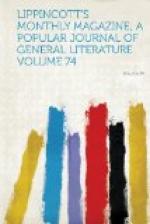A walk of a mile—during which my companion reviewed the uglinesses as well as the beauties of the great Mogol reign with a wise and impartial calmness that amounted to an affectionate rebuke of my inconsiderate effusiveness—brought us to the main gate of the long red stone enclosure about the Taj. This is itself a work of art—in red stone banded with white marble, surmounted by kiosques, and ornamented with mosaics in onyx and agate. But I stayed not to look at these, nor at the long sweep of the enclosure, crenellated and pavilioned. Hastening through the gate, and moving down a noble alley paved with freestone, surrounded on both sides with trees, rare plants and flowers, and having a basin running down its length studded with water-jets, I quickly found myself in front of that bewilderment of incrustations upon white marble which constitutes the visitor’s first impression of this loveliest of Love’s memorials.
I will not describe the Taj. This is not self-denial: the Taj cannot be described. One can, it is true, inform one’s friends that the red stone platform upon which the white marble mausoleum stands runs some nine hundred and sixty feet east and west by three hundred and twenty north and south; that the dome is two hundred and seventy feet high; that the incrustations with which the whole superstructure is covered without and within are of rock-crystal, chalcedony, turquoise, lapis-lazuli, agate, carnaline, garnet, oynx, sapphire, coral, Pannah diamonds, jasper, and conglomerates, brought respectively from Malwa, Asia Minor, Thibet, Ceylon, Temen, Broach, Bundelcund, Persia, Colombo, Arabia, Pannah, the Panjab, and Jessalmir; that there are, besides the mausoleum, two exquisite mosques occupying angles of the enclosure, the one built because it is the Moslem custom to have a house of prayer near the tomb, the other because the architect’s passion for symmetry demanded another to answer to the first, whence it is called Jawab ("the answer"); that out of a great convention of all the architects of the East one Isa (Jesus) Mohammed was chosen to build this monument, and that its erection employed twenty thousand men from 1630 to 1647, at a total cost of twelve millions of dollars; and, finally, that the remains of the beautiful queen variously known as Mumtazi Mahal, Mumtazi Zemani and Taj Bibi, as well as those of her royal husband, Shah Jehan, who built this tomb to her memory, repose here.
[Illustration: MUSSULMAN SCHOOL AT ALLAHABAD.]
But this is not description. The only way to get an idea of the Taj Mahal is—to go and see it.
“But it is ten thousand miles!” you say.
“But it is the Taj Mahal,” I reply with calmness. And no one who has seen the Taj will regard this answer as aught but conclusive.
But we had to leave it finally—it and Agra—and after a railway journey of some twelve hours, as we were nearing Allahabad my companion began, in accordance with his custom, to give me a little preliminary view of the peculiarities of the town.




